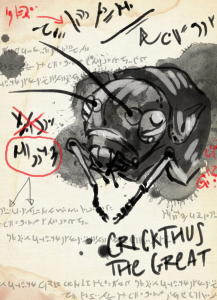An essay by Edward Mathis, as provided by Hamilton Perez
Art by Leigh Legler
You were likely drawn to The Epic of Centipidus by one of two factors. The first is the legend itself: full of mystery, intrigue, adventure, and war, taking place on the smallest grand theater a story can be set. Whether it be the pill bugs rolled down mole-hills, crushing enemies in their path; or the labyrinthine, cavernous abode of the ants which no traveler can escape without the aid of the capricious Queen; or the taciturn hero, who famously has “more legs than words at his disposal,” it’s no wonder the epic has been described as “the Iliad of insects.”[1]
I suspect, however, that what brought you was not the wonder of the tale, but the second factor, which has received far more attention.
It began with my insistence that I be listed as the book’s translator, rather than its author. This, of course, begged the question: Who wrote it? and my answer has turned friends and colleagues against me, but it also inspired a trend of searching uncut lawns for strange glyphs written on grass leaves.
As academics debated the issue, the media largely lampooned it. Fox News did a roundtable discussion which cast the unlikely spotlight on “experts” in the field. Forget Joe the Plumber–Terry the Exterminator is here to tell you there are no bug languages, bug cultures, or bug books.
The Nightly Show did a skit in which Larry Wilmore interviewed a giant grasshopper in Groucho Marx disguise. The conspicuously named Hugh Mann claimed to be an entomologist and assured us that there is no secret insect society, and we should all just go about our lives grazing grasslands and raising pupae.[2]
Despite the evidence included in the appendices, skeptics have persisted in painting me as a puppet master pulling strings in an elaborate and theatrical hoax. But it was never my ambition to inspire the budding field of cultural entomology. That was something passed on to me by my father, and I think it cost him his life.
~
The last I ever heard from him was a strange voicemail he left me. He’d found something unusual on his Missouri acreage, something he couldn’t make sense of. “If you look closely–” The message cut off.
When I tried getting hold of him, my calls just went to the answering machine. Dad refused to own a cell phone, let alone carry one, so at first I didn’t worry. But after a few days without word, I grew concerned. He was all alone out there; meanwhile, I was deconstructing texts half a country away.
Three days after that first message, the phone rang. I rushed to answer it, and on the other end, the compassionate but no less official voice of Seligman P.D. asked if I was Gregory Mathis, Dad’s next of kin.
The tinny voice informed me that a neighbor found him in his home, sprawled across the kitchen floor after an apparent stroke.
All sorts of things ran through my head then–none of them what should have: “If you look closely–”
It didn’t occur to me that there might be a connection between his final message and his death. Not until after I returned to my old home and saw the strange glyphs he’d been drawing, the leaf-litter scattered through his office, did the uneasy sense of foul play first creep into my mind.

In order to keep incoming generations literate and in touch with their cultural heritage, it was necessary to periodically introduce crickets from the fields into the terrarium. When I first spotted Crickthus, I mistook him for a cockroach, so large was he and so dark his coat. But he was clearly writing, perched atop a thick blade of grass.
Editor’s Note: Edward Mathis was reported missing four days after submitting this introduction. Authorities are following several leads regarding his whereabouts.
[1] Anthony Gallego. “A Bug’s Lie.” Time Mar. 2016: 64. Print.
[2] Of course, insects don’t actually rear their young. One can’t help feeling the joke would have landed better if a little more research had been put in beforehand.
To read the rest of this story, check out the Mad Scientist Journal: Spring 2017 collection.
Edward Mathis is a cultural entomologist, lecturer, and the acclaimed translator of many controversial texts including Seven-Legged Spider, Stone and Carapace, and The Life and Death of Icthyl.
Hamilton Perez is a writer and freelance editor living in Sacramento, California. He enjoys long walks through the woods and things that aren’t real. His stories have also appeared in Daily Science Fiction and Between Worlds.
Leigh’s professional title is “illustrator,” but that’s just a nice word for “monster-maker,” in this case. More information about them can be found at http://leighlegler.carbonmade.com/.
“Introduction to the Epic of Centipidus” is © 2017 Hamilton Perez
Art accompanying story is © 2017 Leigh Legler
